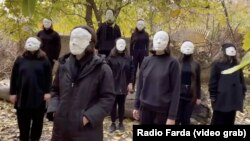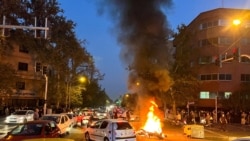There are new indications that Iran’s Islamist rulers have constrained their morality police force that sparked nationwide protests in September, but researchers say the curtailment is not universal and merely reflects a shift in government tactics for suppressing dissent.
“In larger Iranian cities like Tehran, a reduced presence of the morality police has been observed and reported to us,” said Mahmood Amiry-Moghaddam, director of the Oslo-based Iran Human Rights group, in an interview for VOA’s latest Flashpoint Iran podcast.
In an email sent to VOA on Friday, Roya Boroumand, co-founder of Washington-based rights group, the Abdorrahman Boroumand Center, said she has received anecdotal evidence that the morality police are not deployed in some of the Iranian capital's wealthy neighborhoods.
Iran’s reformist state-approved news site Ham-Mihan presented a similar picture in a December 5 article, reporting that the morality police’s ubiquitous white-and-green striped vans had not been seen on Tehran streets since September 16.
That was the date that Mahsa Amini, a 22-year-old Iranian Kurdish woman, died in morality police custody three days after they arrested and — according to activists — beat her for allegedly not wearing her hijab in accordance with strict Islamist rules. News of her death sparked continuing nationwide protests in one of the greatest challenges to Islamist rule in Iran since its 1979 Islamic Revolution.
The Ham-Mihan article said the entrance of Tehran’s morality police building on Vozara Street also has been closed or partially closed since September 16.
Iran’s ruling Shiite clerics have required all women and girls older than 9 to cover their hair in public since the 1979 revolution. They established the morality police to enforce those rules in the mid-2000s.
The aggressiveness of morality policing in Iran fluctuated over the years, but it had toughened under Iran’s ultraconservative President Ebrahim Raisi, who took office in 2021.
The outrage in Iran about the alleged violent treatment of Amini by the morality police, and the rapid transformation of that outrage into demands by protesters for an end to Islamist rule, appear to have pressured the government into scaling back some morality police activities.
“Iranian security forces are stretched and their strategy, in Tehran at least, may be to not aggravate the public by detaining one girl walking with no headscarf, for example. They probably don’t want to be filmed dragging someone unveiled into a van,” Boroumand said. “But the security forces are not necessarily retreating in the face of protesters.”
Amiry-Moghaddam said Iran’s leaders have prioritized the deployment of those forces to control the most significant protests in the country.
“They also are trying to rebuild their fearsome public reputation that has fallen down since the beginning of the protests. And one way they do that is through death sentences for and executions of protesters,” he said.
Women emboldened
In another indication of morality policing being curtailed in Iran’s main cities, women in those cities appear to have become more emboldened to flout mandatory hijab rules.
VOA’s Persian service has observed an increasing number of videos being posted on social media this month, showing what appear to be women in Tehran with their hair uncovered in public. VOA cannot independently verify the locations and dates of the videos as it is barred from reporting inside Iran.
One clip shared on Twitter by the London-based Persian network Iran International on December 11 shows the backs of two women without hijabs walking together along a street. The network’s tweet said it received the video from a male audience member who identified the women as his wife and her sister and said they were walking on Tehran’s Enqelab Street, a major thoroughfare in the capital, on the evening of December 10. The male narrator of the clip ends it by saying the popular protest slogan “Woman. Life. Freedom” in Persian.
Another video obtained by VOA’s sister network Radio Farda and posted to Twitter December 12 shows what the network said is a female Iranian student with no hijab in Tehran, spray-painting the slogan #Execution_Republic in Persian on a wall. The tweet said the student was protesting the execution of two Iranian men whom authorities in the Islamic republic had arrested for participating in recent protests.
The men, 23-year-olds Mohsen Shekari and Majidreza Rahnavard, were hanged December 8 and 12 respectively after what rights activists said were grossly unfair and speedy trials on charges of serious protest crimes.
The growing willingness of women in major Iranian cities to eschew the hijab is reflected in the results of a survey published in Persian, December 13 by the “Iran Open Data” team of the London-based nonprofit group Small Media, whose work also has been cited by Radio Farda.
The group said it surveyed 5,582 internet users based in all of Iran’s 31 provinces from November 17 to 21, with an equal share of men and women participating and 97% of respondents living in urban areas, mostly around Tehran.
It said eight out of 10 women surveyed stated that they went outside their homes without wearing a hijab during the first one to two months of the protest movement. It said only 7% of female respondents reported facing criticism or warnings for not wearing a hijab, with the rest stating that they either received encouragement for doing so or noticed no reaction from other people.
Iranian Attorney General Mohammad Jafar Montazeri hinted at the curtailment of Iran’s morality police on December 3 at a news conference by saying the force had been “closed” by whoever created it and asserted that the judiciary was not involved. He added that the judiciary would continue to “regulate people’s behavior” in society.
There has been no confirmation of the morality police’s closure from the Iranian interior ministry that oversees the force or from the Supreme Council of Cultural Revolution that established it. Rather, there have been signs that enforcement of mandatory veiling has continued in some parts of Iran, with both the morality police and the judiciary playing a role.
The December 5 report by Ham-Mihan said the morality policing in religious cities had been different from that of Tehran in the preceding days.
“A number of women living in Qom have told Ham-Mihan in the past month that the activities of [morality police] patrol cars have increased in the streets of this city,” the news site said.
Elsewhere, a report published Monday by the Iranian state news agency IRNA said the general and revolutionary prosecutor of northwestern Iran's Qazvin province shut down five local businesses for serving women who were not wearing hijabs. IRNA said the prosecutor, Hossein Rajabi, told the news agency that the closure of the businesses, which include three coffee shops, a fast-food restaurant and a bakery, would last one week to a month.
Amiry-Moghaddam said the actions of Iran’s Islamist rulers show they are not serious about reforms that might enhance freedoms for women and society at large.
“The morality police are just one tool for oppressing people in a totalitarian system,” he said. “If the authorities ever manage to reassert control over the country, then we will see all of these oppressive forces come back and maybe even more harshly.”









